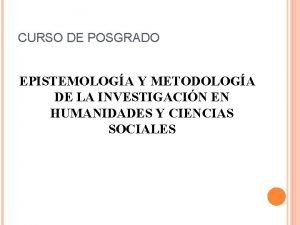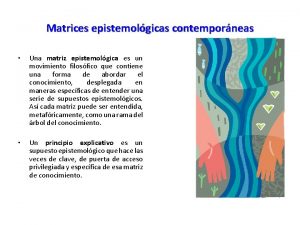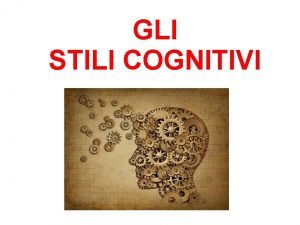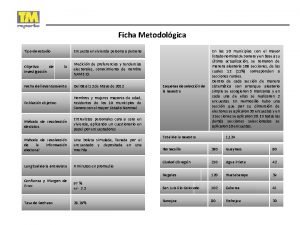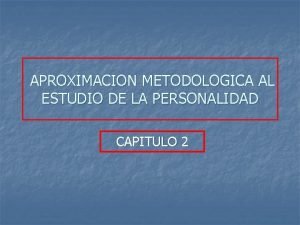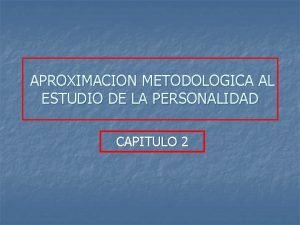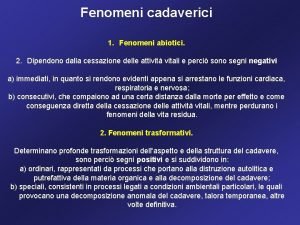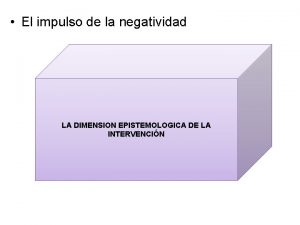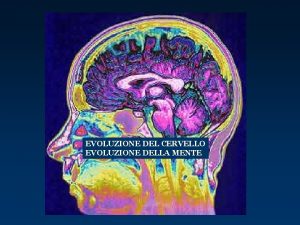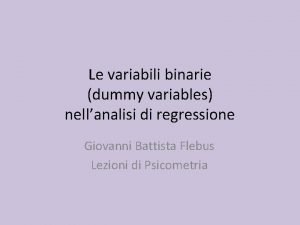Evoluzione epistemologica e metodologica nellanalisi di fenomeni cognitivi



![Contribution to comparative psychology: methodology […] Dr. J. Crichton Browne has also often noticed Contribution to comparative psychology: methodology […] Dr. J. Crichton Browne has also often noticed](https://slidetodoc.com/presentation_image_h/a74676a4cdae3a904402de6354584bc4/image-4.jpg)








































- Slides: 44

“Evoluzione epistemologica e metodologica nell’analisi di fenomeni cognitivi nel Regno animale” Enrico Alleva e Simone Macrì Istituto Superiore di Sanità, Roma, Italy. Laboratorio di Neuroetica e cognizione sociale Roma, 18 -12 -2015

Charles Darwin 1809 -1882

Contribution to comparative psychology: methodology Questionnaire administered to collaborators aimed at evaluating the expression of emotions across different races.
![Contribution to comparative psychology methodology Dr J Crichton Browne has also often noticed Contribution to comparative psychology: methodology […] Dr. J. Crichton Browne has also often noticed](https://slidetodoc.com/presentation_image_h/a74676a4cdae3a904402de6354584bc4/image-4.jpg)
Contribution to comparative psychology: methodology […] Dr. J. Crichton Browne has also often noticed in melancholic patients who keep their eyebrows persistently oblique, "a peculiar acute arching of the upper eyelid. " A trace of this may be observed by comparing the right and left eyelids of the young man in the photograph (fig. 2, Plate II. ); […] But the most conspicuous result of the opposed contraction of the abovenamed muscles, is exhibited by the peculiar furrows formed on the forehead. […] http: //darwin-online. org. uk

Contribution to comparative psychology: methodology Fig. 9. Cat, savage and prepared to fight. Fig. 15. Cat terrified at a dog. http: //darwin-online. org. uk Fig. 10. Cat in an affectionate frame of mind.

Jane Goodall (1934 -)


Donald R. Griffin (1915 -2003)

Aldo Fasolo (1943 -2014)

Ethical considerations P. Bateson, When to experiment on animals. New Scientist, 109 (1986), pp. 30– 32

Keeping in mind Patrick Bateson’s cardinal view of neurobehavioral development in mammals as a process akin to the metamorphosis of a caterpillar into a butterfly Bateson, P. (1981) Ontogeny of behaviour. Br Med Bull 37, 159 -164






Morris Water Maze

Barnes Maze

How do we measure pain in laboratory animals? The hot-plate test

How do we measure pain in laboratory animals? RESPONSES NOCICEPTIVE Forepaw licking Standing on hindlimbs and licking forepaws in a washing action Hindpaw licking Head tilted towards hindpaw with ventral surface angled upwards Testicle licking Self explained, rare EXPLORATORY/ESCAPE RESPONSES Wall rearing Standing on hindlimbs and touching the wall of the apparatus with the forepaws Rearing Standing on hindlimbs Jumping from the hot-plate surface From: F. Cirulli, L. De Acetis, E. Alleva (2000)

Latency (s) How do we measure pain in laboratory animals? ** *p<0. 05; **p<0. 01 From: F. Cirulli, L. De Acetis, E. Alleva (2000) * 52°C 55°C - Not isolated (5/cage) Isolated

How do we measure pain in laboratory animals? Luminous heat source Apparatus used for the tail-flick test The tail-flick test

How do we measure pain in laboratory animals? The formalin test

How do we measure pain in laboratory animals? Vacca et al. , Brain, Behavior, and Immunity, Volume 26, Issue 3, 2012, 489 - 499

How do we measure pain in laboratory animals? Macrì et al. , Neurotoxicity Research, Volume 24, 2013, 15 - 28

How do we measure pain in laboratory animals? Aghajani et al. , PLo. S ONE, 8(11): e 80650.

Pain and distress in laboratory animals and the study of empathy and optimism in animals

Pain and distress in laboratory animals and the study of empathy and optimism in animals Empathy: The ability to understand share the feelings of another D J Langford et al. Science 2006; 312: 1967 -1970

Pain and distress in laboratory animals and the study of empathy and optimism in animals D J Langford et al. Science 2006; 312: 1967 -1970

Pain and distress in laboratory animals and the study of empathy and optimism in animals D J Langford et al. Science 2006; 312: 1967 -1970

Pain and distress in laboratory animals and the study of empathy and optimism in animals D J Langford et al. Science 2006; 312: 1967 -1970

Pain and distress in laboratory animals and the study of empathy and optimism in animals D J Langford et al. Science 2006; 312: 1967 -1970

Pain and distress in laboratory animals and the study of empathy and optimism in animals

Pain and distress in laboratory animals and the study of empathy and optimism in animals Formalin injection

Pain and distress in laboratory animals and the study of empathy and optimism in animals Formalin injection

Pain and distress in laboratory animals and the study of empathy and optimism in animals Formalin injection

Pain and distress in laboratory animals and the study of empathy and optimism in animals Formalin injection

Pain and distress in laboratory animals and the study of empathy and optimism in animals Role of stressors in mediating empathy response Mice under variable stressful conditions Unfamiliar dyads (students) Martin et al. , 2015, Current Biology 25, 326– 332 Unfamiliar dyads (after videogame playing)

Pain and distress in laboratory animals and the study of empathy and optimism in animals • • Depressed state; pessimism Feelings of helplessness and hopelessness Loss of interest in daily activities Appetite or weight changes Sleep changes Anger or irritability Loss of energy Reckless behavior.

Pain and distress in laboratory animals and the study of empathy and optimism in animals • • Depressed state; pessimism Feelings of helplessness and hopelessness Loss of interest in daily activities Appetite or weight changes Sleep changes Anger or irritability Loss of energy Reckless behavior.

Pain and distress in laboratory animals and the study of empathy and optimism in animals Pessimism (cognitive bias? ) “… people in a negative state are more likely to make negative judgements about future events or ambiguous stimuli (‘pessimism’) than people in positive states who show more optimistic judgements and interpretations…” (Mendl et al. , 2009)

Pain and distress in laboratory animals and the study of empathy and optimism in animals Pessimism (cognitive bias? )

Pain and distress in laboratory animals and the study of empathy and optimism in animals Pessimism (cognitive bias? )

Pain and distress in laboratory animals and the study of empathy and optimism in animals Pessimism (cognitive bias? ) Harding and Mendl, Nature, 2004
 Ontologia epistemologia y metodologia
Ontologia epistemologia y metodologia Projeto de pesquisa cronograma
Projeto de pesquisa cronograma O que é epistemologia
O que é epistemologia Matriz epistemologica
Matriz epistemologica Fuente institucional del curriculum
Fuente institucional del curriculum Fuente epistemológica del currículum
Fuente epistemológica del currículum Stile cognitivo impulsivo
Stile cognitivo impulsivo Stili di apprendimento slide
Stili di apprendimento slide Per feuerstein i deficit cognitivi sono originati da una
Per feuerstein i deficit cognitivi sono originati da una Lo stile cognitivo
Lo stile cognitivo Processi cognitivi
Processi cognitivi Processi cognitivi freddi
Processi cognitivi freddi Funzioni cognitive
Funzioni cognitive Stili cognitivi e stili di apprendimento cadamuro pdf
Stili cognitivi e stili di apprendimento cadamuro pdf Planificacion social
Planificacion social Ficha metodológica
Ficha metodológica Objetivo general ejemplos
Objetivo general ejemplos Términos empíricos y teóricos ejemplos
Términos empíricos y teóricos ejemplos Aproximación metodológica
Aproximación metodológica Analisi metodologica
Analisi metodologica Matriz de amarração metodológica
Matriz de amarração metodológica Aproximacion metodologica
Aproximacion metodologica Secuencia del juego libre en los sectores
Secuencia del juego libre en los sectores Justificacion teorica ejemplo
Justificacion teorica ejemplo Actividad curricular ejemplo
Actividad curricular ejemplo Como hacer una justificacion
Como hacer una justificacion Verifica storia evoluzione dell'uomo
Verifica storia evoluzione dell'uomo Evoluzione prebiologica
Evoluzione prebiologica Evoluzione normativa diritto del lavoro
Evoluzione normativa diritto del lavoro La scuola è pubblica amministrazione?
La scuola è pubblica amministrazione? La nascita della lingua italiana mappa concettuale
La nascita della lingua italiana mappa concettuale Nulla ha senso
Nulla ha senso Cespuglio evolutivo wikipedia
Cespuglio evolutivo wikipedia Evoluzione storica della normativa sull'inclusione
Evoluzione storica della normativa sull'inclusione Evoluzione del romanzo dall'800 al 900
Evoluzione del romanzo dall'800 al 900 Embriologia comparata evoluzione
Embriologia comparata evoluzione Cladogramma evoluzione uomo
Cladogramma evoluzione uomo Evoluzione dei telefoni
Evoluzione dei telefoni Valerio parisi genetica ed evoluzione
Valerio parisi genetica ed evoluzione Rutherford esperimento
Rutherford esperimento Strumenti di misurazione del tempo
Strumenti di misurazione del tempo Evoluzione
Evoluzione Legge biot savart
Legge biot savart I fenomeni elettrostatici
I fenomeni elettrostatici Pençe el deformitesi
Pençe el deformitesi
